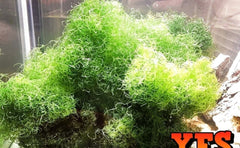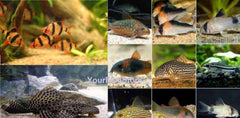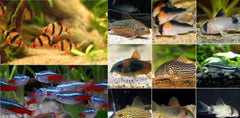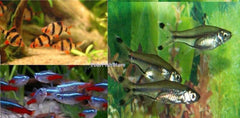X10 Assorted Betta Fish Package
Ebay
$ 138.53

X10 ASSORTED BETTA FISH PACKAGE - YOURFISHSTORE FREE SHIPPING
They will be scooped out our holding tanks. We cannot guarantee we will be able to scoop ALL different types, but we will try to get a good variety.
We will bag a random selection from the list below:
Dumbo Super Delta
Black Orchid Crowntail
Twintail Plakat Betta
Twintail Halfmoon Betta
Red Rosetail Betta
Plakat Koi Betta
Crowntail Dragonscale
Marble Betta
Crowntail Betta
Betta Ferox
Dragonscale Betta
Halfmoon Rosetail
Bicolor Halfmoon Betta
Koi Halfmoon Betta
Minimum Tank Size: 1 gallon
Care Level: Easy
Temperament: Peaceful
Water Conditions: 75-86° F, KH 0-25, pH 6.0-8.0
Max. Size: 3"
Color Form: Assorted, Blue, Red
Diet: Carnivore
Diet
A well-balanced Betta diet consists of:
A variety of flakes, pellets, freeze-dried bloodworms and frozen food to ensure complete nutrition.
Feeding
Things to remember when feeding your Betta:
Feed sparingly and no more than fish can eat in 1 to 2 minutes; overfeeding can quickly foul the water, especially in smaller, unfiltered aquariums.
Thaw frozen foods before feeding.
Baby bettas require a smaller pellet or finely crushed flake food when when feeding.
Housing
Keep in an appropriately sized aquarium. Bettas must be able to breathe from the surface of the water. They prefer water with little or no current.
Male bettas are kept individually and do best in habitats of one liter (approximately a quarter of a gallon) or larger. Male bettas can live successfully in a community tank that does not have aggressive fish (such as tiger barbs) or fish that bettas may become aggressive toward (such as fancy guppies). Female bettas may be housed with other community fish or other female bettas.
Stable water quality and parameters are critical to the health of aquatic life. If you are unsure of your water quality, Petco provides free water testing.
Characteristics
Bettas breathe from the water's surface with their labyrinth organ in addition to their gills.
Bettas will "flare" fins when threatened or disturbed and to show aggression.
Male bettas will attack other male bettas and males have also been known to attack similar-looking fish and fish with flowing fins.
Habitat Maintenance
Daily: check filter, water temperature and other equipment (if used).
Weekly: Check water quality at least once a week. Do a 50% water change for small habitats (less than 2 gallons) once a week. In larger aquariums, change 10 to 25% of the total volume of water every 2 to 4 weeks, or more often as needed.
Compatibility
Male bettas must be kept in individual tanks or be the only betta in a community aquarium. Female bettas can be kept in a community tank. Do not keep male and female bettas together.
Betta Fish Facts
Fact One: Bettas Breathe Above and Below the Water
Unlike most fish that only breathe by collecting oxygen from the water through their gills, the betta can breathe below the water's surface as well as from above it. Bettas have an organ called a labyrinth located just behind their heads that allows them to breathe air. They can rise to the water's surface and take a gulp of air, and then swim back down as they please.
In the wild, bettas live in very slow-moving waters with less-than-ideal amounts of oxygen. The labyrinth evolved to help these fish collect enough oxygen to survive. Of course, bettas still need to live in the water even if they can breathe regular air.
Fact Two : Bettas Need Protein
Bettas will pick at almost anything you feed them, but they primarily need protein. You can keep a pet healthy on a main diet of betta pellets, but your fish will also appreciate the occasional meal of live or frozen brine shrimp and freeze-fried bloodworms. Feed your pet daily, but no more than three pellets at a time, and any other remaining food in tank must be removed after five minutes. Bettas are prone to constipation, so some hobbyists recommend that you let your betta fast one day a week.
Fact Three: Male Bettas Are Highly Territorial
When you visit an aquarium shop, you'll notice that bettas are mainly displayed in small, individual containers. If you see one in a community tank, it's most likely the only one of its species. That's because bettas are highly territorial toward one another, and they will fight all the way to the death to defend their territory, if necessary. They don't appear to be quite as territorial toward other species, but they will still nip their tank mates occasionally.
Fact Four: Females Offer More Bluster than Bite
Females are territorial, but not quite so fiercely territorial as males. For this reason, you can keep them in what is referred to by hobbyists as a sorority tank. It's recommended that the group is no smaller than five females, and the tank must provide at least a minimum of one gallon of water per fish. It's best to introduce the females all at the same time. They will have a number of spats over the first 24 to 48 hours until they determine their individual territory, and then they tend to settle down. Any fins damaged during these skirmishes typically heal in a few weeks. Make sure the tank has plenty of plants to provide the girls with places to have a quiet retreat.
QUESTIONS & ANSWERS
Ask a Question-
How many do you get in s package
Hello this package contains a total of ten fish.














